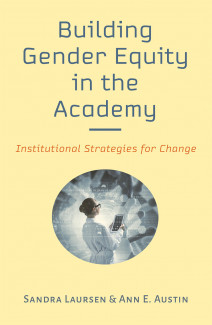
Johns Hopkins UniversityEst. 1876
America’s First Research University
Now Browsing:
Building Gender Equity in the Academy: Institutional Strategies for Change

Addressing the complex challenges facing the world requires the scientific and technical expertise of many people whose diverse talents can make a difference. Universities and colleges contribute to that work through research, teaching, and public engagement, yet these institutions have not tapped into the full array of talent that is available to accomplish such goals. Women, people of color, people with disabilities, lesbian, gay, trans and genderqueer, and Indigenous people are among those who have been marginalized simply because of their identities. Not only do they face extra challenges in their individual careers, but society does not benefit when their diverse talents and perspectives are excluded from the scientific enterprise.
We became interested in the approaches and strategies used by universities and colleges that have been engaged in institutional transformation, funded by the National Science Foundation’s (NSF) ADVANCE Program, to heighten gender equity and create more diverse, inclusive, equitable academic environments, especially for women faculty in STEM fields. Funded by the NSF, we conducted interviews, focus groups, and institutional case studies, and share findings in our book, Building Gender Equity in Academy: Institutional Strategies for Change. Here we highlight several major points from the book.
First, recognize the problem. Women in STEM fields in the academy experience multiple, persistent, and systemic barriers and pressures that thwart their success, visibility, and career progress. Underrepresentation and lack of visibility at different levels of the academy are some signals that there is a problem, but they are symptoms, not a diagnosis.
Underlying such patterns, masculinized cultures characterized by implicit bias, discrimination, sexual harassment, and unwelcoming climates, and gender-based expectations and pressures from managing personal and professional responsibilities are daily factors that accumulate to create a great disadvantage for women over time. Challenges become even greater for women when gender intersects with other personal identities that are marginalized. African-American women face overlapping but distinct barriers as compared to white women, for instance. Yet, the contributions of women in teaching, research, community outreach, and collaboration are essential to achieving the missions of higher education institutions.

Second, think in systemic ways. The pervasive and embedded nature of the problem must be addressed as a systems challenge. This requires multiple strategies and interventions that tackle the myriad factors fostering inequity.
Third, context matters. Developing a strategic, systemic, and effective approach to institutional transformation is required to dismantle barriers and create more inclusive environments. This requires careful analysis of the specific problems, policies, practices, and cultures of the particular institution. Proven strategies do exist, but, to effect transformative change, they must be selected and adapted to fit the context.
The book identifies twelve strategies, based on our research, that institutional leaders can use to advance this type of institutional transformation. We have organized them into four categories. Often campus-based efforts to address inequities start by assisting women directly so that they can manage, persist, and succeed despite the challenges they confront. Thus, we highlight strategies in a category we call “Support the Whole Person,” including support for dual-career couples, flexible work arrangements, and family-friendly accommodations. In another category, “Foster Individual Success,” we include faculty professional development programs, grants to individual faculty, and mentoring and networking approaches.
Providing support for individuals is not enough, however. Tackling the problem requires changing the organization and its processes. Thus, we identify a set of strategies that “Interrupt Biased Processes,” including inclusive recruitment and hiring, equitable processes of tenure and promotion, and strengthened accountability structures. Another set of strategies aims to “Reboot Workplaces,” seeking to develop leaders, improve departmental climate, and enhance visibility for women and gender issues. In the book, our discussion of each strategy explains its purpose, affordances, and limitations, as well as possible adaptations for different contexts.
Because our overall goal is to help institutional leaders engage in transformative change, we close the book with a discussion of how important it is to build and enact a change portfolio. We explain how to analyze the particular institutional context, including the specific barriers to achieving greater diversity, inclusion, and equity—and then consider how to build a portfolio of strategies that interact to create powerful levers for change. While our research focused on efforts to address gender equity in STEM fields, many universities have found that these strategies are effective in creating more inclusive environments for all faculty, across fields and identities, who experience marginalization.
As higher education institutions commit to transformative change in support of gender equity and diverse, inclusive environments, we look forward to seeing more people thrive in academe. And we anticipate the benefits that result for the broader society when the full range of talent within the academy is welcomed and encouraged. This book provides leaders committed to strengthening diversity and equity in academe with effective approaches and tools to do this important and challenging work.
Order Building Gender Equity in the Academy: Institutional Strategies for Change at the following link: https://jhupbooks.press.jhu.edu/title/building-gender-equity-academy
Sandra Laursen is the director and senior research associate of Ethnography & Evaluation Research at the University of Colorado Boulder. She is the coauthor of Undergraduate Research in the Sciences: Engaging Students in Real Science. Ann E. Austin is a University Distinguished Professor in Higher, Adult, and Lifelong Education and the associate dean for research in the College of Education at Michigan State University. She is the coauthor of Rethinking Faculty Work: Higher Education's Strategic Imperative. Together, Laursen and Austin are the authors of Building Gender Equity in the Academy: Institutional Strategies for Change.

We became interested in the approaches and strategies used by universities and colleges that have been engaged in institutional transformation, funded by the National Science Foundation’s (NSF) ADVANCE Program, to heighten gender equity and create more diverse, inclusive, equitable academic environments, especially for women faculty in STEM fields. Funded by the NSF, we conducted interviews, focus groups, and institutional case studies, and share findings in our book, Building Gender Equity in Academy: Institutional Strategies for Change. Here we highlight several major points from the book.
First, recognize the problem. Women in STEM fields in the academy experience multiple, persistent, and systemic barriers and pressures that thwart their success, visibility, and career progress. Underrepresentation and lack of visibility at different levels of the academy are some signals that there is a problem, but they are symptoms, not a diagnosis.
Underlying such patterns, masculinized cultures characterized by implicit bias, discrimination, sexual harassment, and unwelcoming climates, and gender-based expectations and pressures from managing personal and professional responsibilities are daily factors that accumulate to create a great disadvantage for women over time. Challenges become even greater for women when gender intersects with other personal identities that are marginalized. African-American women face overlapping but distinct barriers as compared to white women, for instance. Yet, the contributions of women in teaching, research, community outreach, and collaboration are essential to achieving the missions of higher education institutions.

Second, think in systemic ways. The pervasive and embedded nature of the problem must be addressed as a systems challenge. This requires multiple strategies and interventions that tackle the myriad factors fostering inequity.
Third, context matters. Developing a strategic, systemic, and effective approach to institutional transformation is required to dismantle barriers and create more inclusive environments. This requires careful analysis of the specific problems, policies, practices, and cultures of the particular institution. Proven strategies do exist, but, to effect transformative change, they must be selected and adapted to fit the context.
The book identifies twelve strategies, based on our research, that institutional leaders can use to advance this type of institutional transformation. We have organized them into four categories. Often campus-based efforts to address inequities start by assisting women directly so that they can manage, persist, and succeed despite the challenges they confront. Thus, we highlight strategies in a category we call “Support the Whole Person,” including support for dual-career couples, flexible work arrangements, and family-friendly accommodations. In another category, “Foster Individual Success,” we include faculty professional development programs, grants to individual faculty, and mentoring and networking approaches.
Providing support for individuals is not enough, however. Tackling the problem requires changing the organization and its processes. Thus, we identify a set of strategies that “Interrupt Biased Processes,” including inclusive recruitment and hiring, equitable processes of tenure and promotion, and strengthened accountability structures. Another set of strategies aims to “Reboot Workplaces,” seeking to develop leaders, improve departmental climate, and enhance visibility for women and gender issues. In the book, our discussion of each strategy explains its purpose, affordances, and limitations, as well as possible adaptations for different contexts.
Because our overall goal is to help institutional leaders engage in transformative change, we close the book with a discussion of how important it is to build and enact a change portfolio. We explain how to analyze the particular institutional context, including the specific barriers to achieving greater diversity, inclusion, and equity—and then consider how to build a portfolio of strategies that interact to create powerful levers for change. While our research focused on efforts to address gender equity in STEM fields, many universities have found that these strategies are effective in creating more inclusive environments for all faculty, across fields and identities, who experience marginalization.
As higher education institutions commit to transformative change in support of gender equity and diverse, inclusive environments, we look forward to seeing more people thrive in academe. And we anticipate the benefits that result for the broader society when the full range of talent within the academy is welcomed and encouraged. This book provides leaders committed to strengthening diversity and equity in academe with effective approaches and tools to do this important and challenging work.
Order Building Gender Equity in the Academy: Institutional Strategies for Change at the following link: https://jhupbooks.press.jhu.edu/title/building-gender-equity-academy
Sandra Laursen is the director and senior research associate of Ethnography & Evaluation Research at the University of Colorado Boulder. She is the coauthor of Undergraduate Research in the Sciences: Engaging Students in Real Science. Ann E. Austin is a University Distinguished Professor in Higher, Adult, and Lifelong Education and the associate dean for research in the College of Education at Michigan State University. She is the coauthor of Rethinking Faculty Work: Higher Education's Strategic Imperative. Together, Laursen and Austin are the authors of Building Gender Equity in the Academy: Institutional Strategies for Change.

Login to View & Leave Comments
Login to View & Leave Comments


